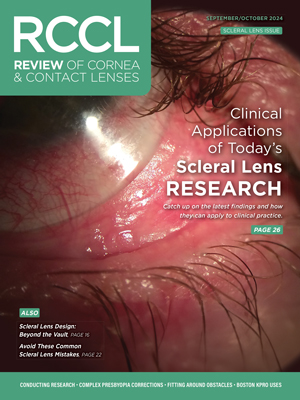Patients sit in our exam chair every day and describe ocular issues that run the gamut from a little blurry vision to sight- and even life-threatening conditions. As eye care practitioners, we focus on healing, alleviating discomfort and, at the very least, offering some palliative options. As exciting as it can be to immediately employ today’s supremely effective pharmaceuticals, it is important to remember that many cases can be managed appropriately with a high-quality artificial tear.
Ocular surface lubrication often is the key component to ensuring proper healing—both in the immediate (e.g., following refractive surgery) and the long-term (e.g., prevention of recurrent corneal erosions) phases of corneal regeneration. And of course a multitude of conditions in between, which we most often encounter, stand to benefit from copious lubrication as well.
For most practitioners, the problem is not offering artificial tears as an option but rather selecting the most appropriate one, given the clinical circumstances. We need to know and understand the artificial tear products on the market to prescribe the right one, as well as educate the patient as to why this particular option is ideally suited to their condition.
In this article, we’ll provide an overview of the different artificial tears and moisturizers on the market today, discuss how they differ, and explain why it is important to understand all the options available.
The Artificial Tear Options
ODs are well aware of the traditional model of human tears that separates the tear film into three distinct layers. The anterior lipid layer, containing oils secreted by the meibomian glands, coats the aqueous layer and provides a hydrophobic barrier that retards evaporation. Next, the aqueous layer—consisting of water and other substances, such as proteins secreted by Krause’s, Wolfring’s and lacrimal glands—serves to promote spreading of the tear film, control infectious agents and regulate osmotic forces. Finally, the inner-most mucous layer, secreted by the conjunctival goblet cells, coats the cornea with a hydrophilic surface to allow for even distribution of the tear film.
Understanding the human tear can help us better differentiate artificial tear products by the layers they affect and their active ingredients. Because differing demulcent systems can have diverse effects when treating dry eye, we try to place these products into several clearly delineated categories:
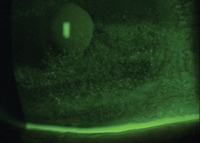
1. Diffuse fluorescein corneal SPK helps identify dry eye patients.
• Cellulose-based eyedrops are the most common type of artificial tears. The advantage of cellulose is that it adds volume to the aqueous layer of tears. Examples include Refresh Tears and Refresh Liquigel (Allergan), and Tears Naturale and Genteal (Alcon).
• Glycerin-based drops are designed to help lubricate the ocular surface and increase the spreading of the tears by treating the aqueous and mucin layer of the tears. Examples include Refresh Optive (Allergan), Blink Tears (Abbott Medical Optics), Oasis Tears (Oasis Medical) and Systane Ultra (Alcon).
• Emusions or oil-based derivatives include drops such as Systane Balance (Alcon), Refresh Endura (Allergan) and Soothe XP (Bausch + Lomb). These agents are designed to help replace the lipid layer of the tear film and prevent evaporation.
Associated challenges common to all the aforementioned products include difficulty in clearing the eye without disrupting vision, the risk of potentially washing out the tears too quickly, and the presence of ingredients that may cause burning and/or stinging upon instillation.
An eye care practitioner must be able to choose the right product for each specific condition or situation. For instance, a sudden-onset keratitis due to improper use of a contact lens solution may require a different type of tear product than what is necessary for a chronic dry eye patient, or someone who is suffering from severe meibomian gland dysfunction.
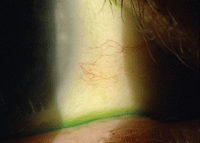
2. Conjunctival lissamine green staining may help identify mild to moderate dry eye patients.
Dry Eye
It’s easy for some doctors—perhaps even a few optometrists—to dismiss dry eye as a mere nuisance, but keep in mind that moderate to severe dry eye can be debilitating for many patients. We most frequently prescribe artificial tear products to treat dry eye. But the question remains: Can rewetting drops or artificial tears provide prolonged relief? Also, what factors must we consider before application?
In 2007, the International Dry Eye Workshop Study (DEWS) defined dry eye as “a multifactorial disease of the tears and ocular surface that results in symptoms of discomfort, visual disturbance, and tear film instability.”3 Dry eye syndrome, accompanied by increased osmolarity of the tear film and inflammation of the ocular surface, is one of the most frequent eye conditions that we encounter in our practice. Females present with the disease two to three times more frequently than males.4
Lubricating drops may indeed help to relieve the problem, but they also can exacerbate the condition if the appropriate dosing and drop specifications aren’t prescribed. Remember to wet both the ocular surface as well as the contact lens. Rewetting agents for contact lenses are “surface active,” meaning that they are comprised of surfactants and other ingredients that increase the spreading and penetrating properties of the liquid by lowering its surface tension.1 Some drops simply add more tear volume for aqueous deficient dry eyes, while others have coating properties for evaporative dry eye patients. Either way, they are designed to help stabilize the tear film.
By rubbing a drop of rewetting tears between your fingers, you can gauge its surfactant volume. If the drop allows the fingers to glide easily, there is presence of surfactants. If the drop makes the fingers feel “squeaky” to the touch (think of how rubbing alcohol feels on your hands), there is probable lower level of surfactants. Too much surfactant and you emulsify the lipid layer of the tears, which in turn increases tear evaporation and worsens dryness symptoms.2 Keep in mind, you may have to try varying levels of surfactant-comprised rewetting drops before you learn what works best for your contact lens patient.
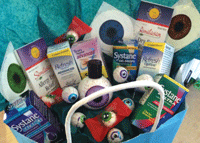
3. The “grab bag” approach: Do you throw a bunch of different artificial drops in a bag and let the patient determine the best one?
What options are on the market today? For patients without lid disease who are looking to add volume for aqueous deficient dry eye, available products include Refresh Optive, Blink Tears, Systane Ultra and Oasis Tears. Some eye care professionals prescribe Soothe XP and Systane Balance for patients with concurrent lid disease and/or evaporative dry eye. FreshKote (Focus Laboratories) may be useful for patients with more severe dry eye and/or recurrent corneal erosion.
While the treatment protocol for dry eye continues to evolve, there are some basic steps that you can recommend to your patients. These include modifying the environment (e.g., limit time on computers and stop using the ceiling fan) and daily routine (e.g., reduce caffeine intake and quit smoking); identifying possible contributing medications (e.g., antihistamines, antidepressants, antihypertensives, antidiuretics and anticholinergics); increasing fluids; and using supplemental nutrients (e.g., omega-3 and omega-6 fatty acids) and artificial tears.5 The next level of treatment often includes punctal plugs and prescription drugs (topical and oral).
However, most dry eye patients need artificial tears at some point in their treatment––so finding the right fit is vital for an optimal outcome.
Preservatives
Preservatives found in topical ocular products are extremely important in maintaining sterility. However, several studies have shown that these agents can cause dose-dependent toxic effects that compromise tear film stability and cause damage to the cornea and conjunctiva.6-8 Preservatives also been shown to alter the lipid layer, affecting its stability and causing excess evaporation, which increases ocular dryness.9 Impairing the protective layers of the tears exposes the eye to inflammation and potential conjunctival metaplasia.10
When more than four to six drops per day are required, prescribe a non-preserved artificial tear to minimize excessive exposure to toxic preservatives. One such product is Lacrisert (Aton Pharma), a sustained-release ophthalmic insert for use with patients suffering from moderate to severe dry eye. The product is inserted into the inferior lid cul-de-sac, and can keep the eye moist for up to 24 hours. Other non-preserved artificial tear products that are available in individual vials include Oasis Tears, Systane Preservative-Free (Alcon), Refresh Free, Blink Free and Tears Naturale (Alcon). Many store brand generics also come preservative-free, but remember to consider other factors before making a recommendation. For example, if the level of osmolarity is too high or too low, it can cause discomfort and interfere with the application of the product onto the ocular surface.
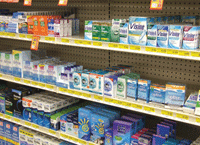
4. What confusing array of products do your patients see when they go to purchase artificial tear products?
Preservative-free tears are particularly beneficial in post-surgical care, as well as in the treatment of acute keratitis. We commonly see patients with sensitivities to the preservative BAK in our practices. For these, and any patients with sensitivities to ophthalmic drug ingredients, the preservative-free option is suggested. For those patients who are regularly using glaucoma medications, allergy eye drops or drops for chronic conjunctivitis, BAK can contribute to burning, stinging, irritation and disruption of overall vision. BAK can also affect the tissues of our eye that support normal tear function, including goblet cells. Consistent use over long periods of time may affect daily comfort and visual performance.
Although sometimes overlooked, artificial tears are an important part of an eye care practitioner’s toolbox. It is important to be familiar with all the different products on the market today, so as to make an informed decision when selecting the best option for your patient. Remember, if you do not properly prescribe the correct treatment to your patient, he or she likely will make the decision without your consultation.
Wesley attended The Ohio State University, where she pursued concurrent degrees in both clinical optometry and masters in vision science. She practices in Medina, Minn.
Jason R. Miller, OD, MBA, is a partner at EyeCare Professionals of Powell, Ohio, and serves as an adjunct faculty member for The Ohio State University College of Optometry.
1. Ward M. Choose rewetting drops and artificial tears with care. CL Spectrum. 2009 Jul. Available at:
www.clspectrum.com/articleviewer.aspx?articleid=103119. Accessed November 2012.
2. Ward M. Contact lens rewetting drops. Refractive Eyecare. 2009:11(16).
3. The definition and classification of dry eye disease: report of the Definition and Classification Subcommittee of the International Dry Eye WorkShop (2007). Ocul Surf. 2007 Apr;5(2):75-92.
4. Schaumberg DA, Sullivan DA, Buring JE, Dana MR. Prevalence of dry eye syndrome among US women. Am J Ophthalmol 2003 Aug;136(2):318-26.
5. Rashid S, Jin Y, Ecoiffier T, et al. Topical omega-3 and omega-6 fatty acids for treatment of dry eye. Arch Ophthalmol 2008 Feb;126(2):219-25.
6. Noecker R. Ophthalmic preservatives: considerations for long-term use in glaucoma patients with dry eye or glaucoma. Rev Ophthalmol. 2001 June;8(6):73.
7. Cha SH, Lee JS, Oum BS, Kim CD. Corneal epithelial cellular dysfunction from benzalkonium chloride (BAK) in vitro. Clin Experimental Opthalmol. 2004 Apr;32(2):180-4.
8. Broadway DC, Greirson I, O’Brien C, Hitchings RA. Adverse effects of topical antiglaucoma medication. I. The conjunctival cell profile. Arch Ophthalmol. 1994 Nov;112(11):1437-45.
9. Detry-Morel M. Side effects of glaucoma medications. Bull Soc Belge Ophthalmol. 2006;299:27-40.
10. Brujic M. When preservatives aggravate dry eye. Rev Cornea Contact Lens. 2010 Jun;146(5):22-4.
